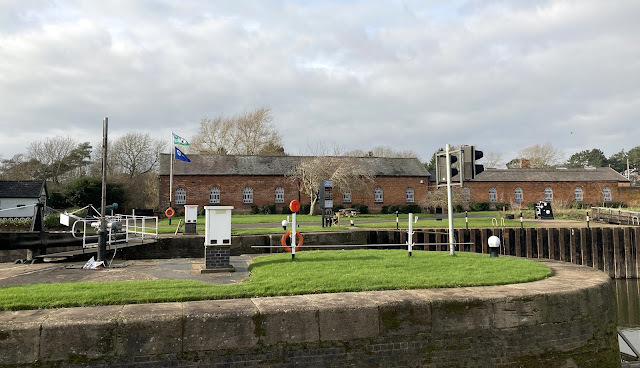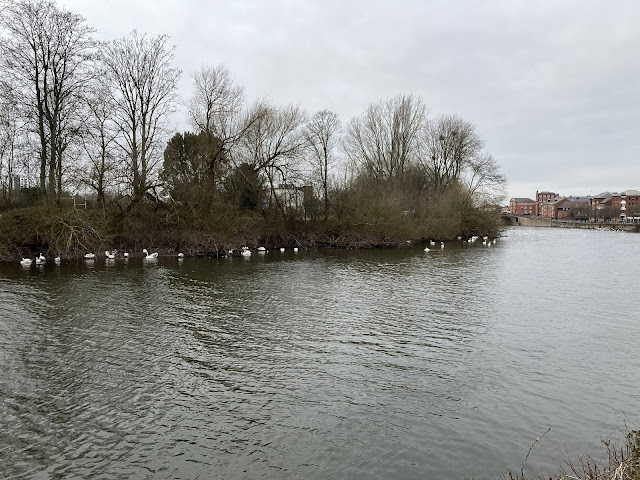'I like painting flowers - I have tried to paint many things in many different ways, but my paint brush always gives a tremor of pleasure when I let it paint a flower....' Winifred Nicholson.
Outgrowing - Flowers and Female Artists, 1700 - Now, at the Leamington Art Gallery.

Women have often been associated with flowers, as both a symbol of their femininity and the subject of their interests. Until the 20th century, women were often excluded from professional and intellectual pursuits, including the arts and sciences, which were considered beyond their understand and irrelevant to their domestic role. The scientific and artistic study of flowers, however, was encouraged as a harmless activity that helped women pass the time, appreciate the natural world, and focus their supposedly innate aptitude for decoration. Furthermore, botany was seen as an appropriate pursuit, encouraging womanly virtues such as sensibility, humility and piety. Furthermore, botany could easily be studied in the home.
Despite society's expectations, many women made significant contributions to the fields of art and botany, gaining public recognition and professional success. From the 17th century to the present day, women have harnessed the power of flowers to reach beyond the status quo and escape the limitations placed upon them, in some cases quite literally, travelling around the world in the pursuit of plants. Those who stayed at home helped to develop a rich culture of craft and design, which has been, as usual, historically unappreciated.
Professional women artists also turned to the subject of flowers because entrance into art schools for women was not generally possible until the mid-19th century and they were prohibited from learning life drawing. Flowers could be easily observed and depicted at home without the need for specialist training. Despite these limitations, a number of women achieved professional and commercial success as flower artists during this period. Mary Moser, for example, was one of only two female founders of the Royal Academy in 1768.
Throughout the 19th century, female painters and watercolourists displayed their works at public exhibitions, including the Royal Academy, capturing the Victorian taste for the natural world. The decorative nature of their work, and the bias they faced as artists often meant that scant information about their life and work was recorded.
I really enjoyed looking at all of the paintings in the exhibition, but even more so, I enjoyed reading about these extraordinary women and what they managed to achieve.
Ann Lee, Crinum Pendulum, 1776, (watercolour on vellum)
Ineligible for formal artistic training, Lee was only able to pursue her art due to family connections with professional male artists. Lee's father ran a plant nursery and knew botanical illustrator Sidney Parkinson, who taught her from the age of 13. She worked in watercolour, which was seen as more suitabe for women artists as it was less messy than oil paint. Her meticulous and beautiful illustrations show real skill, but her name is little known. The stigma around genteel women making money prevented many artists from pursuing their talents professionally.
Margaret Meen, Hycinthoides sp. Geranium phaeum and Viola tricolor, 1780, (watercolour and gouache on vellum)
A very gifted amateur painter, Margaret Meen contributed to the scientific community of the day by painting many of the exotic plants which came to Kew Gardens from around the world. She also started the publication Exotic Plants from the Royal Gardens at Kew in 1790, although only two issues were published.
Sarah Ann Drake, Oncidium Sanguinem, 1839-1841, (pendil and watercolour on paper)
Drake gained renown as a significant botanical illustrator, contributing 1,100 studies to the publication Botanical Register. Together with artist Augusta Innes Withers, she illustrated one of the largest botanical books ever produced, Bateman's Orchidaceae of Mexico and Guatemala. Like many women artists of the period, little is known of Drake after her marriage, and it is likely that she gave up professional illustration.
Matilda Smith, Cereus Paxtonianus, 1899,John Nugent Fitch, Uncoloured lithograph after Matilda Smith for Curtis' Botanical Magazine, 1899
Matilda Smith was the first botanical artist to be paid by the civil service when she was appointed an official artist to Kew Gardens in 1898. This drawing from Curtis' Botanical Magazine was one of over 2,300 illustrations she produced for the publication between 1886 and 1923. The description of her carefully observed illustrations as 'inferior' by some critics is evidence of the obstacles she faced working in the increasingly professionalised and masculine world of 19th and 20th century botany. Two plant species were named after her in recognition of her contribution to the botanical field.
Lillian Snelling, Peaonia Cretica, 1934, (watercolour on paper)
Snelling was one of Britain's most renowned 20th century botanical illustrators. Like many female artists before her, she worked for the Botanical Magazine and was its chief artist between 1922 and 1952. Unlike her female predecessors, Snelling studied the art of lithography, creating engravings of plants from her own watercolours. She received the Royal Horticultural Society's greatest accolade for her work, the Victoria Medal of Honour.
Angela Brazil, Great Bindweed, Herb Robert, Ivy Leaved Toadflax, and Sloe or Blackthorn, 1900-1947.
Writer Angela Brazil, best known for her popular girls' boarding-school stories, was also a dedicated amateur naturalist and botanical artist. Many of her paintings show wildflowers found near her home in Coventry. She focused on the beauty of the underappreciated and and overlooked. This was also reflected in her work as an early conservationist, campaining for the preservation of landscapes and historic monuments.
Margaret Mee, Aechmea Rodriguesiona, Rio Morera Amazones, 1977
Between 1956 and 1988, Mee made 15 expeditions to the Amazon to illustrate the rare species of
flowers found there, many of which had never been recorded. These journeys were extremely dangerous due to the harsh environment of the jungle. Unlike traditional botanical imagery, Mee often gave her plant studies rich, verdant backdrops. She wanted to highlight the importance of the rainforest as a whole in the face of the exploitation and deforestation of the region. Mee's pioneering work to document and protect the Amazon gained her recognition and accolades in both Britain and Brazil.
Margaret Mee, Aechmea Rodriguestiana, Rio Marau Amazones, 1977
In the Regency period, men's waistcoats were often embellished with intricate floral embroidery. The collar, front panels and pocket-flaps were decorated separately by a professional embroiderer, and then cut out and assembled to fit by a tailor. Embroidery was one of the few sources of income available to women, and many specialist seamstresses worked in poor conditions for very little pay.
Girls of all classes were traditionally expected to learn needlework. This was an essential skill at home and could also be a source of income. But from the 18th century, there was also a new expectation that genteel women should have 'accomplishments' or creative skills beyond the practical crafts of sewing and knitting.
The fashion of handicrafts flourished in the 19th century and accurate imitation of nature was especially highly prized.
During the Victorian period women's artistic leisure pursuits led gradually to professional opportunities. For middle-class women who needed to earn a living, there were very few options beyond teaching and nursing. The so-called 'art industries' - designing and making decorative consumer goods - offered a new alternative which was both feminine and respectable, but which gave women a degree of creative freedom.
19th century bone china and porcelain pieces
In the wake of the industrial revolution, the complex processes of ceramic manufacturing were divided among a wide range of specialist workers. Women were usually employed for the delicate tasks of painting and modelling flowers. These were often highly realistic, echoing the accurate depictions of different species shown in still life paintings and botanical illustrations.
Jane Moore, plaque, 1998, (silver and enamel)
Leamington-based jeweller Jane Moore takes inspiration from traditional crafts including embroidery and Japanese floral patterns. Her intricate enamelled designs often feature flower motifs, which bring whimsical and romantic associations to work otherwise characterised by strong colours and geometric lines.
Emily Ledbrook, Roses, (oil on canvas)
Ledbrook lived and worked in Leamington Spa as both an artist and botanical illustrator. Her paintings would probably have been seen as 'decorative'. This somewhat back-handed compliment was predominantly reserved for artworks by female artists.
Elisabeth Whitehead, Peonies, 1928, (oil on canvas)
The looser, dynamic brush strokes used to render the blossoms of these peonies could be testament to Whitehead's youthful experiences of French Impressionism at the Academie Julien in Paris. This was an important experience for Whitehead as she was able to attend life-drawing classes, unlike in British art schools, which did not allow women in these classes. Despite this training, Whitehead continued to focus on flowers, coastal scenes and landscapes in her work perhaps due to the expectations about female artists which she had grown up with.
Vanessa Bell, A Venetian Window, 1926, (oil on canvas)
Vanessa Bell painted a wide variety of subjects throughout her career, but it was through her flower painting that she made her public name and her income. Here, as in many of her paintings, Bell uses the flowers as a focal point through which to explore the boundary between the inside and outside world.
Winifred Nicholson, Summer, 1928, (oil on board)
Nicholson considered flowers to be the perfect subject to encapsulate modern ideas about painting with their unruly bursts of colour and naturally abstract, uncontrollable geometry. She often depicted bunches of flowers in the foreground of her work, placing them on windowsills and tables, and using their colour to activate their surroundings, making the image sing. Here, she uses the flower bed in the same way, enlivening the Cornish landscape beyond.
Jennie Moncur, Pink Admiral, (woven on a wool warp with wool, linen and silk coloured weft threads)
Jennie Moncur constructs her tapestries, millimetre by millimetre, incorporating flower motifs as part of an abstract 'jigsaw' composition. Looking back on the long history of weaving, she describes the 'appealing timeless reassurance when recognising flora, creatively documented centuries ago, which we are still growing and enjoying today'. Her continued interest in flowers is sustained by their vibrant colour, symmetry 'and the suggestion of sunshine'.
Jennie Moncur, Talix Zeal, (woven on a wool warp with wool and linen coloured weft threads)
Finally, another painting by Doc Procter, not of flowers this time. It hangs in the main gallery:
The Innocent, A New Day, (oil on canvas)
Doc Procter is perhaps most acclaimed for her evocative portraits of young women and her subtle use of light. Procter was among the first generation of female artists that had unimpeded access to nude life drawing classes, adding further significance to this work. Her focus on figures on the cusp of womanhood perhaps tells us something of how she saw herself as a woman and an artist at a time of increasing female liberation. Procter's fame grew in the 1920s when her painting Morning, featuring a sleeping woman, won 'Picture of the Year' at the Royal Academy Summer Exhibition in 1927.






























































